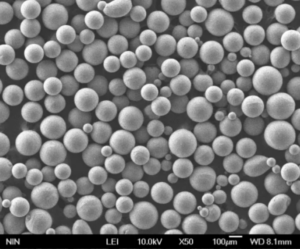Advancements in Additive Manufacturing Powder: Revolutionizing Production Processes
Additive Manufacturing (AM), commonly known as 3D printing, has transformed the manufacturing industry, enabling the creation of complex designs with unprecedented precision. As this technology continues to evolve, one crucial element that has been revolutionized is the additive manufacturing powder. In this article, we will explore the advancements in additive manufacturing powder and how it is reshaping production processes.
Understanding Additive Manufacturing Powder
Additive manufacturing powder serves as the raw material for 3D printing processes. It is typically composed of fine particles, such as metals, polymers, ceramics, or composites. These powders are specifically engineered to meet the requirements of various 3D printing techniques, ensuring optimal performance and end-product quality.
Types of Additive Manufacturing Powder
Additive manufacturing powder comes in a wide range of materials, each with unique properties and applications. Some common types include:
1. Metal Powders
Metal powders, such as titanium, stainless steel, aluminum, and nickel alloys, are extensively used in additive manufacturing. These powders exhibit excellent mechanical strength, heat resistance, and corrosion resistance, making them ideal for industries like aerospace, automotive, and medical.
2. Polymer Powders
Polymer powders, like nylon, polylactic acid (PLA), and polyvinyl alcohol (PVA), offer flexibility, lightness, and ease of processing. They are widely utilized in prototyping, consumer goods, and medical applications. The development of polymer powders has opened up new possibilities for additive manufacturing in diverse industries.
3. Ceramic Powders
Ceramic powders, including zirconia, alumina, and silica, have exceptional thermal and chemical stability. They find applications in dental prosthetics, electronics, and aerospace due to their excellent mechanical properties and biocompatibility.
Advancements in Additive Manufacturing Powder
In recent years, significant advancements have been made in additive manufacturing powder, fueling the growth and adoption of 3D printing technologies. Let’s explore some of the notable developments:
1. Particle Size Control
Fine-tuning the particle size distribution of additive manufacturing powders has become increasingly crucial. Smaller particle sizes offer improved surface finish, dimensional accuracy, and higher packing densities. Manufacturers have focused on enhancing their powder synthesis techniques to achieve precise particle size control.
2. Alloy Development
Advancements in alloy development have expanded the range of materials available for additive manufacturing. New alloy compositions offer enhanced mechanical properties, corrosion resistance, and heat resistance. These developments have paved the way for 3D printing of critical components in industries that demand exceptional performance.
3. Customized Powder Formulations
To cater to specific applications, additive manufacturing powders are now being customized with specific additives and reinforcements. This allows manufacturers to tailor the material properties according to the desired end-use requirements. Customized powder formulations offer improved strength, durability, and functional characteristics.
4. Powder Recycling and Reusability
Efforts are being made to reduce material waste in additive manufacturing processes. Technologies for powder recycling and reusability have gained traction, making 3D printing more cost-effective and environmentally friendly. By implementing closed-loop systems, manufacturers can optimize powder usage and minimize material consumption.
Impact on Production Processes
The advancements in additive manufacturing powder have had a profound impact on production processes across industries. Here are some key benefits:
1. Design Freedom
Additive manufacturing allows for the creation of intricate designs that were previously impossible to manufacture using traditional methods. With the availability of advanced powders, complex geometries, internal channels, and lightweight structures can be realized. This design freedom enables innovation and optimized product performance.
2. Rapid Prototyping
Additive manufacturing powder enables rapid prototyping, significantly reducing the time and cost involved in developing prototypes. Manufacturers can quickly iterate and refine designs, accelerating the product development cycle. This agility facilitates faster time-to-market and gives businesses a competitive edge.
3. Mass Customization
The customization potential of additive manufacturing is unparalleled. By leveraging advanced powders, products can be personalized to meet specific customer requirements without incurring significant additional costs. Mass customization opens up opportunities for niche markets, catering to individual preferences and enhancing customer satisfaction.
4. Supply Chain Optimization
Additive manufacturing powder allows for on-demand production, reducing the need for large inventories and optimizing the supply chain. By printing components as needed, manufacturers can minimize storage costs and respond quickly to market demands. This decentralized production model has the potential to transform traditional supply chains.
Conclusion
The advancements in additive manufacturing powder have revolutionized the production processes, unlocking new possibilities and reshaping industries. From fine-tuning particle size to alloy development and customized formulations, these advancements have paved the way for innovative designs, rapid prototyping, mass customization, and optimized supply chains. As additive manufacturing continues to evolve, further advancements in powder technology will continue to drive the industry forward, unlocking even greater potential.
Frequently Asked Questions (FAQs)
Q1: Can additive manufacturing powders be used with any 3D printing technology?
A1: Additive manufacturing powders are specifically designed to be compatible with different 3D printing technologies. However, it is essential to select the appropriate powder for the specific printing process and equipment being used.
Q2: How are additive manufacturing powders synthesized?
A2: Additive manufacturing powders are synthesized through various methods, including gas atomization, plasma atomization, and mechanical alloying. These processes ensure the production of fine, consistent particles with desired material properties.
Q3: Are there any limitations to using additive manufacturing powders?
A3: While additive manufacturing powders offer numerous advantages, there are some limitations to consider. These include material costs, limited material choices compared to traditional manufacturing, and the need for post-processing steps to achieve desired surface finishes.
Q4: Can additive manufacturing powders be recycled?
A4: Yes, many additive manufacturing powders can be recycled and reused. Powder recycling systems are being developed to collect and filter used powder, ensuring its quality for subsequent printing processes.
Q5: What future advancements can we expect in additive manufacturing powder?
A5: The future of additive manufacturing powder holds exciting possibilities. We can anticipate further advancements in particle size control, alloy development, sustainability efforts, and the introduction of new materials, expanding the scope of 3D printing applications even further.

